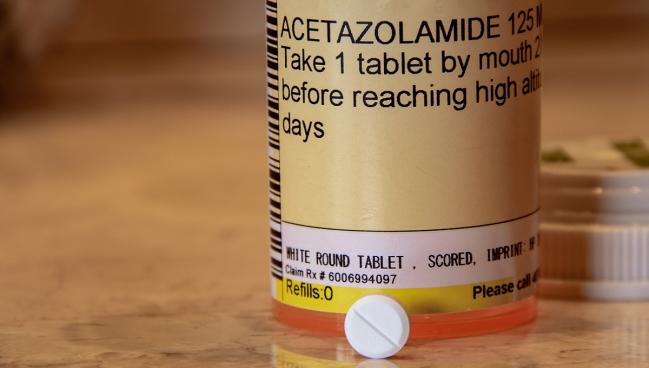Old Drug Acetazolamide Offers New Tricks in Acute HF: ADVOR
The loop diuretic adjunct is likely to “see a good amount of use” in clinical practice, Michael Felker says.

Adding acetazolamide to conventional loop diuretics can improve the rate of decongestion in hospitalized acute decompensated heart failure (HF) patients better than diuretics alone, according to data from the randomized ADVOR trial.
Acetazolamide is a carbonic anhydrase inhibitor with diuretic effects that has been around for at least 70 years and is most frequently used today in the treatment of mountain sickness and some types of glaucoma. The ADVOR investigators found that compared with patients who did not receive the addition of IV acetazolamide to loop diuretics, those who did were discharged sooner and were less likely to have residual clinical signs of volume overload.
“ADVOR is the first trial ever in acute heart failure to show a positive result with regards to very clinically important relevant endpoints,” lead author Wilfried Mullens, MD, PhD (Ziekenhuis Oost-Limburg, Genk, Belgium), said in a press conference prior to the study’s presentation at the European Society of Cardiology Congress 2022. It was also simultaneously published in the New England Journal of Medicine.
Mullens noted that in the only other trial of loop diuretic strategies in hospitalized HF patients with decongestion as an endpoint—the DOSE trial— only 15% of patients were considered “dry” and free from clinical congestion after 72 hours of treatment with furosemide. In comparison, the use of IV acetazolamide and loop diuretics in ADVOR was associated with a 46% higher chance of successful decongestion after 72 hours, which translated to a 42.2% success rate in the acetazolamide group versus a 30.5% success rate in the placebo group (P < 0.001). The findings were generally consistent across all prespecified subgroups.
G. Michael Felker, MD (Duke University School of Medicine and Duke Clinical Research Institute, Durham, NC), who led the DOSE trial and wrote an editorial accompanying ADVOR, said the results are exciting.
“Even though we use diuretics in practice, we don't actually have that much high-quality data to support specific strategies. We all take care of patients who are diuretic resistant or not responding well to diuretics, and we're looking for something else to try. Here's something that has good safety data and it’s inexpensive,” Felker told TCTMD. “I suspect we'll see a good amount of use of this strategy in clinical practice.”
According to Mullens, generic acetazolamide costs about US $8.00 (EUR €8) per dose.
No Safety Issues
ADVOR was an investigator-initiated multicenter RCT that randomized patients from 27 sites in Belgium to 500 mg once daily intravenous acetazolamide (n = 259) or placebo (n = 260). The majority of patients in each group were white and male, with a mean age in their late 70s. Approximately two-thirds had heart failure with preserved ejection fraction (HFpEF) and one-third had heart failure with reduced ejection fraction (HFrEF). All had at least one clinical sign of volume overload—edema, pleural effusion, or ascites—and an N-terminal pro-B-type natriuretic peptide (NT-proBNP) level of > 1,000 pg/mL or a B-type natriuretic peptide level > 250 pg/mL.
At randomization, oral loop diuretics were stopped, and patients received an IV loop diuretic at double the oral maintenance dose split into two doses on each of the next 2 days. Bolus acetazolamide or matching placebo was given simultaneously with the first dose of loop diuretics each day. Urine output was monitored, with the protocol mandating an escalation of decongestive treatment if the cumulative urinary output over 30 to 48 hours was < 3.5 liters and signs of fluid overload were still present.
We all take care of patients who are diuretic resistant or not responding well to diuretics, and . . . here's something that has good safety data and it’s inexpensive. G. Michael Felker
Excluding the need for escalation therapy and defining successful decongestion as the absence of a congestion score > 1, more patients in the acetazolamide group than in the placebo group had successful decongestion (44.9% vs 33.2%; RR 1.42; 95% CI 1.15-1.76). Additionally, among all patients who were alive at discharge (n = 190), more of those in the acetazolamide group than in the placebo group had successful decongestion (78.8% vs 62.5%; RR 1.27; 95% CI 1.13-1.43). The number needed to treat to prevent one excess case of congestion at discharge was 6.
The mean index hospitalization in the acetazolamide group was 8.8 days, compared with 9.9 days in the placebo group (RR 0.89; 95% CI 0.81-0.98). Death from any cause or rehospitalization for HF at 3 months occurred in 29.7% of the acetazolamide group and 27.8% of the placebo group (HR 1.07; 95% CI 0.78-1.48). In safety analyses, rates of the combined renal safety endpoint, hypokalemia, and hypotension were similar for both groups. In four patients on acetazolamide and in one on placebo, renal replacement therapy was required during hospitalization (P = 0.21). According to Mullins, these patients all presented with cardiogenic shock and the need for renal replacement was not unexpected. Overall, he said, there was no signal of harm seen in any patients in the trial, matching what has been seen in decades of experience with acetazolamide.
Practical Implementation and Moving Forward
In addition to a lack of diversity among the trial population, a major limitation of ADVOR is that patients on sodium-glucose cotransporter 2 (SGLT2) inhibitors were not included. For much of the trial period, which spanned 2018 to early 2022, these now widely used drugs were not yet indicated or available.
“I don't think there is any safety issue with regards to the combination of SGLT2 inhibitors and acetazolamide,” Mullins told TCTMD. “Both drugs work proximally in the kidney; however, SGLT2 only blocks sodium reabsorption [at a rate of about] 5%, while this drug does it for 60% of the proximal tubule.” He added that “based on solid physiological reasoning,” the additive effect of the SGLT2 would not be expected to lessen the efficacy of the acetazolamide-loop diuretic combination.
“I don't think there's any strong rationale to believe this strategy wouldn't work in patients on SGLT2 inhibitors,” Felker added. “It's a clear limitation of [ADVOR], but I don't think it will actually be the kind of thing that keeps people from using the strategy because . . . it makes sense.”
While only speculation, he said, the efficacy of acetazolamide in patients on SGLT2 inhibitors could be additive, subadditive, or synergistic. Another unknown is the risks and benefits of acetazolamide compared with other commonly used diuretics such as metolazone. “This was a placebo-controlled trial, but obviously there would be interest in doing a head-to-head trial versus metolazone, generating more data on people who are already on SGLT2 inhibitors, and testing this in broader populations moving forward,” Felker concluded.
L.A. McKeown is a Senior Medical Journalist for TCTMD, the Section Editor of CV Team Forum, and Senior Medical…
Read Full BioSources
Mullens W, Dauw J, Martens P, et al. Acetazolamide in acute decompensated heart failure with volume overload. N Engl J Med. 2022;Epub ahead of print.
Felker GM. New decongestion strategies in an evolving heart failure landscape. N Engl J Med. 2022;Epub ahead of print.
Disclosures
- Mullens reports consulting/speakers fees from Abbott, AstraZeneca, Bayer, Boehringer Ingelheim, Boston Scientific, Medtronic, and Novartis.
- Felker reports serving as a consultant for AstraZeneca, Boehringer Ingelheim, Bristol Myers Squibb, Cardionomic, Cytokinetics, Novartis, Reprieve, and Sequana.





Comments